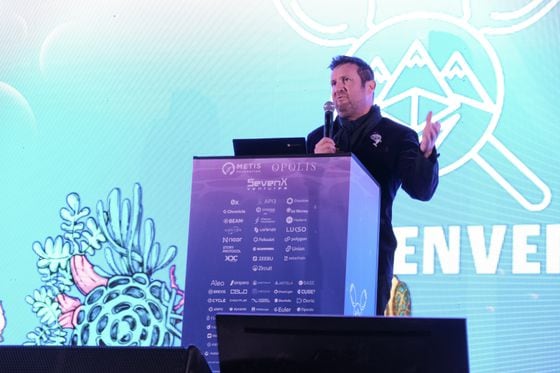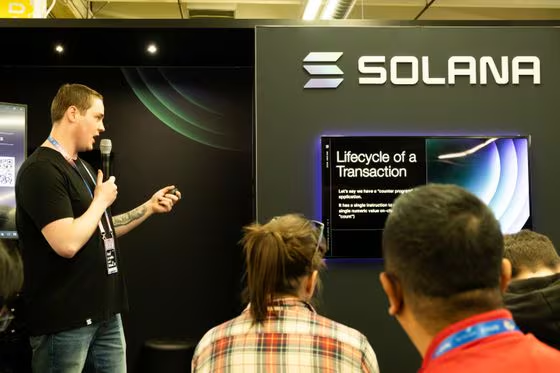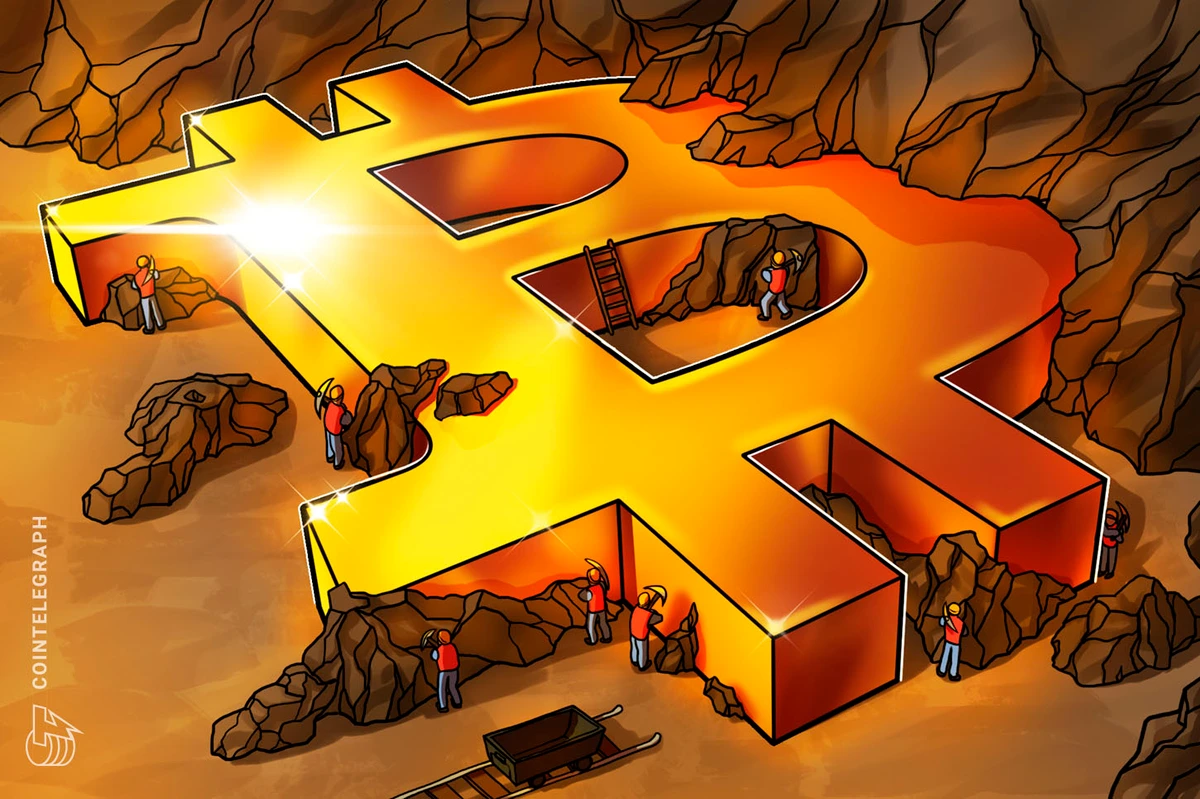Ethereum’s Influence and the Rise of Competing Blockchain Ecosystems
The ETHDenver conference, which took place last week, garnered a strong presence from developers and representatives of various blockchain ecosystems outside of Ethereum. This further highlights the growing influence of the second-largest distributed network.Bitcoin and Solana Fans Invade Ethereum Conference in Denver – With a Purpose
Last week’s ETHDenver conference, originally focused on the Ethereum blockchain, drew a presence from developers and teams focused on other ecosystems, including Bitcoin, Solana, and Polkadot. This broad attendance reveals Ethereum’s influence and reach, as well as the potential competition it faces.
The Expanding Reach of Ethereum
In the past, Ethereum conferences were primarily attended by Ethereans. However, this year’s ETHDenver conference in Colorado showcased the increasing interest from the broader blockchain industry. Developers and users from various blockchain ecosystems gathered to explore the possibilities offered by Ethereum.
This diverse turnout signifies Ethereum’s impact on other blockchain ecosystems, attracting onlookers from different crypto tribes. It also reflects the desire of rival systems to tap into Ethereum’s success in making blockchains more programmable. Ethereum’s vibrant ecosystem of software developers creates an environment ripe for new applications and innovations.
Bitcoin, undergoing a developer renaissance with the introduction of its own NFTs and decentralized finance (DeFi) services, had a strong presence at the conference. Polkadot, the blockchain created by Ethereum co-founder Gavin Wood, and Solana, which positions itself as an “ETH Killer,” also had well-attended booths.
- Osprey Bitcoin Trust Considers Sale or Merger: What You Need to Know
- The Rise of Fidelity Bitcoin ETF: A Big Moment for Bitcoin and ETFs 🚀
- Stanford University’s Blyth Fund Invests in Bitcoin: What Does It Mean for the Crypto Market?
According to John Paller, the conference’s founder, “probably seven or eight layer 1s that are here, and we have probably 12 layer 2s” showcased their presence at ETHDenver.
Embracing Competitors in the Ethereum Community
The camaraderie between different blockchain ecosystems at ETHDenver might have seemed out of place in the past when maximalism dominated the industry. However, it is now natural for networks to seek integration with Ethereum’s developer community.
Ethereum’s longevity and its position as the first virtual machine that developers interact with make it an attractive starting point for many newcomers in the ecosystem. As Ethereum faces its own set of challenges, such as high transaction fees, other layer 1 blockchains are integrating and collaborating with Ethereum to stay relevant.
The rise of layer 2 solutions, which enhance Ethereum’s scalability and reduce fees, has increased the Ethereum community’s comfort level in working across multiple blockchains. This openness to collaboration and interoperability is leading to an expansion of the “Ethereum ecosystem” to encompass other blockchain ecosystems.
Christine Kim, Vice President of Research at Galaxy Digital, highlights the evolving nature of the Ethereum community, stating that as users and developers become more flexible and versatile across different protocols, increased integration with other blockchain ecosystems is inevitable.
ETHDenver 2024: A Big Tent
Ethereum’s most notable weakness is its high transaction fees, which can often make even a simple token swap cost over $10 in fees alone. Ethereum acknowledges this issue but does not plan to significantly reduce fees in the future.
To address this problem, Ethereum has embraced rollups, which are “layer 2” solutions that settle transactions on the Ethereum chain but offer lower fees and faster speeds for users. With the growing adoption of rollup networks like Arbitrum, Optimism, and Coinbase’s Base, Ethereum’s vision of becoming rollup-centric has materialized.
Although rollups are still separate networks with their own programming, app ecosystem, and community, the talk of interoperability between rollups naturally leads to conversations about increased interoperability with other execution environments. The Solana VM and the Cosmos ecosystem, for example, are potential candidates for such collaboration.
The “Data Availability” Challenge
As Ethereum expands its umbrella to include other blockchains, it must confront one of its limitations: data availability. Blockchains often rely on other networks known as data availability layers to store transaction data for formal verification.
While Ethereum can serve as a data availability layer, there are other networks like Celestia and Filecoin that specialize in data availability. These networks provide more cost-effective solutions compared to Ethereum, which suffers from high fees and costs.
Ethereum’s upcoming upgrade, Dencun, aims to improve the network’s data availability for layer 2 services by introducing “danksharding.” This upgrade will make it easier for layer 2s to store transaction information on the Ethereum chain. However, Ethereum’s cost disadvantage compared to other data availability networks may hinder its ability to catch up in this area.
The Risk and Future Outlook for Ethereum
As Ethereum embraces layer 2 solutions and cross-chain interoperability, it faces the risk of losing its dominance as a general-purpose platform for general-purpose compute. Although Ethereum currently boasts the largest developer community and decentralized finance ecosystem, the trend of blockchain modularity is challenging its position.
Apps that historically resided on a single blockchain are now deploying elements of their programs across different blockchain architectures. Ethereum’s speed, cost, and data storage limitations are incentivizing developers to explore alternative options. If a blockchain ecosystem emerges with better technology and the ability to create a stronger and more durable community than Ethereum, it stands a chance of displacing Ethereum’s general-purpose platform status.
While the future remains uncertain, the builders from other blockchain ecosystems are eagerly waiting for an opportunity to disrupt the status quo. Ethereum must continue to innovate, address its weaknesses, and nurture its vibrant developer community to maintain its leadership position.
💡 Q&A Content:
Q: What are the challenges faced by Ethereum’s rollups?
Rollup solutions offer scalability and lower fees for Ethereum, but they still depend on the Ethereum chain and face challenges of their own. One challenge is ensuring data availability and interoperability between rollups and other blockchain ecosystems. While Ethereum’s rollups function well within the Ethereum ecosystem, integrating with other execution environments, such as the Solana VM or the Cosmos ecosystem, poses technical and logistical hurdles.
Q: Will Ethereum’s transaction fees be reduced in the future?
Ethereum acknowledges its high transaction fees but has no plans to significantly reduce them. Instead, Ethereum is focusing on implementing layer 2 solutions, such as rollups, to mitigate the impact of high fees. These rollups settle transactions on the Ethereum chain but offer lower fees and faster speeds to users. By leveraging these layer 2 solutions, Ethereum aims to make transactions more affordable and scalable without compromising the security of the underlying blockchain.
Q: How does Ethereum’s expansion to new ecosystems affect the broader blockchain industry?
The expansion of Ethereum to new ecosystems aligns with the broader trend of blockchain modularity. Rather than being confined to a single blockchain, applications are becoming cross-chain, utilizing components from different blockchain architectures. This trend is driving innovation and spurring competition among various blockchain ecosystems. As Ethereum continues to evolve and potentially loses its dominance as a general-purpose platform, the landscape of the blockchain industry will become more diverse and dynamic.
🔍 References:
- Layer 2 Rollup Networks: A Practical Guide
- Ethereum’s Approach to Data Availability
- The Future of Blockchain Modularity
- Ethereum’s Transaction Fee Challenges
- Exploring Ethereum’s Competitors: Solana and Polkadot
📣 Engage with us on social media! Share your thoughts and join the discussion. Don’t forget to tag us @BlockchainExperts
Image credits:
-
John Paller, founder and executive steward of ETHDenver. (Sam Kessler)

-
Solana booth at ETHDenver 2024 conference. (Sam Kessler)

We will continue to update Blocking; if you have any questions or suggestions, please contact us!
Was this article helpful?
93 out of 132 found this helpful
Related articles
- Baanx Expands to US Market and Secures $20 Million in Funding
- Bitcoin Soars, Approaching All-Time Highs, Amidst ETF Speculation and Investor Frenzy 🚀💰
- Bitcoin Breaks All-Time High Against Euro, Reaching €60,000
- Ethereum Price Surge: Heading Towards $4,000 Resistance Zone 🚀💰
- MicroStrategy’s Stock Price Surges as Bitcoin Investments Pay Off 💰💸
- Bitcoin Hits All-Time High Against Canadian Dollar, Defying Critics
- Bitcoin Price Hits Record Highs, More than Just a Bull Run





